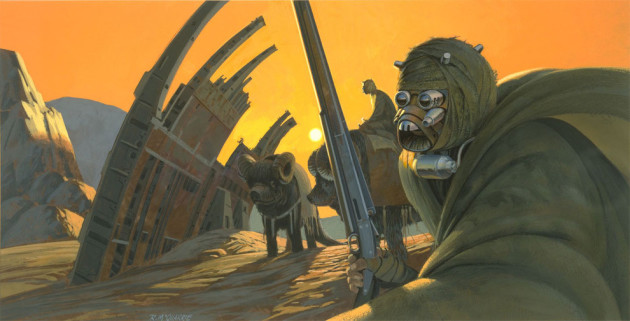Search Results for: the wall
We’re so close I can taste it! My favorite day of the year. A day when people come together to share love and food and joy. A day when a man dressed up in a costume can make even the most hardened Grinch melt into a warm puddle. A day when it seems like the universe is binding everyone together. I’m talking, of course, about December 18th, Star Wars: The Force Awakens opening day.
Which is what inspired today’s post. As I was going through all my Star Wars scripts, I found this, the very first Star Wars treatment from the bearded magician himself, George Lucas. And what did I notice upon reading this document? Genius? The future of a 20 billion dollar franchise? A slew of pop culture phrases that would permeate the very fabric of our society for 30 years?
Nuh-uh.
I found something that was going to require a ton of fleshing out before it approached anything remotely close to a ground-breaking movie. You can read it for yourself but here are the highlights…
1) The attack on the Death Star comes without explanation in the very first scene.
2) It takes place not a long time ago and not in a galaxy far far away, but in the 33rd century and in our very own galaxy!
3) Luke Skywalker is a full-formed general who’s guarding Leia at the beginning of the film.
4) There is no mention of “The Force.”
5) There is no Obi-Wan Kenobi.
6) There is no Han Solo or Chewbacca.
7) R2-D2 and C-3PO are replaced by two bumbling human bureaucrats.
8) Luke and Leia are transporting “spice” through an Imperial section of the galaxy.
9) Luke, Leia and the bureaucrats get marooned on a desert planet, where they must take a road trip across the planet to get to a spaceport and fly to the safety of a friendly planet. This desert planet is where the majority of the movie is set.
10) We never actually go to The Death Star.
11) There’s no Darth Vader.
12) They end up at the planet Yavin, where Luke and Leia get split up, and Luke must train a bunch of youngsters to help him rescue Leia.
This is what you get in your first treatment, your first outline, or your first draft. Ideas. But you don’t yet get something original that brings those ideas together. It’s a blob of first-take concepts in search of a structure. Each draft then allows you to get rid of pieces, add pieces, and move the remaining pieces around, until you find that great movie every good idea has the potential to be. In fact, here are five of the most prominent beneficiaries of multiple drafts.
ELIMINATING INFLUENCES
We are all slaves to our favorite films. They are the reason we got into this business. And whether we know it or not, every script we write is a version of one of these movies. That manifests itself in characters, plot points, and ideas from these films seeping into our first drafts. You see it here. A desert planet. Transporting “spice.” Our characters battling giant beasts in the middle of the desert. “Dune,” anybody? What subsequent drafts allow us to do is identify these influences and weed them out. Or at least push them into the background, away from the main plot. If you don’t go through this crucial step, you’re going to get a lot of people criticizing you for copying [insert your favorite movie here].
PLOT OVER CHARACTER
When you write an outline or a first draft, you barely know your characters. As such, you tend to focus on the plot. And we can see that here. This treatment is all plot and doesn’t mention once anything about the relationships between the characters. We don’t even know how Luke or Leia feel about one another. Subsequent drafts allow you to live with your characters for awhile just like living with real people. You get to know them, and once you know them, you can start building a life around them, as well as building the relationships between these people. There’s nothing that benefits more from rewriting than character.
IDENTIFYING WHAT’S COOL AND WHAT ISN’T
When you write a first draft, you’re not sure what’s cool yet. You have ideas, but mainly you’re just throwing a bunch of shit at the wall. In subsequent drafts, your goal is to identify which pieces of shit are sticking. You then start crafting your screenplay around these hotspots. A perfect example here is the Death Star. It’s mentioned at the beginning of the treatment then never again. Over the course of rewriting the story, Lucas obviously realized what am amazing and interesting idea this space station planet was. He’d make it the centerpiece of the villains’ story and build an entire sequence inside of it. Never get hung up on the ideas in your first draft. Be open to exploring new avenues, particularly anything that looks like it might have potential to make your script more interesting.
NO VILLAIN
I don’t know why this is, but it’s pretty common that first drafts don’t have villains. I think it has something to do with the writer concentrating so hard on their heroes and the journey (the plot) that they don’t think about creating a villain. I read tons of scripts that have gone into the 5th or 6th drafts that still haven’t included a villain. That’s not to say that every movie needs a villain, but usually when there’s an edge missing in your story, it’s because you don’t have a villain. And we see that here. This treatment is straight-forward sci-fi fodder with people driving across deserts and fighting aliens. Darth Vader had not been created yet. I want you to think about that for a second. The greatest villain in the history of cinema was not in George Lucas’s first treatment. Might you be depriving the world of the greatest villain in history?
COMBINING TIME
The biggest issue in first drafts is that everything takes 10 times longer than it should. And it makes sense why. Your brain is still working everything out and it extends the sequences in the film as a result. Subsequent drafts require you to compress time as much as possible. For instance, it takes Luke and Leia 45-60 minutes to travel across the desert planet and get to the spaceport of “Mos Eisley.” In the movie, it takes 1 second. We’re in Obi-Wan’s hut, and then a second later we cut to Obi-Wan and Luke, having driven to a cliff, looking over Mos Eisley. Here’s a phrase to remember: “Time combine.” Start combining that time, folks!
Hope this helped with your current script. May the force be with you, always!
Get Your Script Reviewed On Scriptshadow!: To submit your script for an Amateur Review, send in a PDF of your script, along with the title, genre, logline, and finally, something interesting about yourself and/or your script that you’d like us to post along with the script if reviewed. Use my submission address please: Carsonreeves3@gmail.com. Remember that your script will be posted. If you’re nervous about the effects of a bad review, feel free to use an alias name and/or title. It’s a good idea to resubmit every couple of weeks so your submission stays near the top.
Genre: Horror
Premise (from writer): A strange old man tells scary campfire stories to two young boys. But who is the man, why are the boys in the stories and where are their parents?
Why You Should Read (from writer): Early in the year, you wrote a couple of posts, the gist being – You want to stand out in the current spec market? You need to take risks. So, I sucked up that advice, threw caution to the wind and the result is this very different little horror script. It takes the sort of structural and narrative risks I normally wouldn’t.
Writer: Ashley Sanders
Details: 86 pages
Atmosphere.
Every horror film needs it.
But how much atmosphere is too much?
The most atmospheric horror movie of all time is probably Suspiria. Story is placed on the back burner in favor of terrifying imagery and eerie music. And it works like cheese on tacos. You don’t forget that movie after you’ve seen it.
Which I’m guessing was Ashley’s inspiration here. She says in her WYSR that she wanted to move away from convention. As long as you have a solid understanding of storytelling, I encourage this.
But what I often find happens to a writer going off on one of these “experimental” journeys is that they embrace the “fuck it” attitude a little too excitedly. It’s as if they think NOTHING should make sense, less the script fall back into the dreaded “c” word (convention).
But even when you’re writing something different, you still need to follow some rules. Just like if you wanted to build a house that nobody’s built before, there are still some common things you’ll need to add – like walls.
Small Slices walked that line a little too liberally and while there’s some good stuff here, I’m not sure there are enough walls to keep it from falling down.
The script takes place in a forest at night, with a man known simply as “the storyteller” telling two brothers, Mark (7), and Tom (9), (both played by Michael Shannon), a series of scary stories.
The stories center on a family led by shady businessman David and his trophy wife, Sara, who have two kids named, you guessed it, Mark and Tom.
One day, the couple receives a mysterious grandfather clock in the mail. While their initial inclination is to turn it away, the thing looks so old and interesting that they figure it might be worth some money, so they keep it.
Tick tock. Bad move.
Every night at 4:20 AM, the doors to the clock open and some creepy cardboard puppet-kids come out and do a little creepy dance. This is followed by the sound of scratching, which eventually moves beyond the clock and into the walls of the house, resulting in a lot of spooked out family members trying to figure out what the hell is going on.
Occasionally, we’ll break out of this story to come back to the Storyteller, who will tell little side stories about the characters, some of which turn them into different people doing inexplicable things.
One of my favorites was when Sara walks through the park to see a man standing next to tree with a bunch of whining dogs tied up to it. It turns out the man is digging a hole to bury the dogs in. He asks for Sara’s help, and she obliges.
But as the hole gets deeper, the man disappears, and the park’s residents, furious that this woman has stolen all their dogs and was planning to bury them, proceed to bury Sara alive! Yeah, talk about creepy!
Eventually, our family gets rid of the grandfather clock, but by then, it’s too late. The clock’s scratch-happy inhabitant has moved into the walls. And he’s not leaving until he turns a few family members into clock pie.
Just from this synopsis, you can tell there’s some fertile horror ground to play with.
But the script’s over-dependence on dream sequences made it hard to stay interested in. Dream sequences don’t fit well into movies. You should avoid them like gas station hot dogs. The few that succeed, though, tend to be of the horror variety. That’s because you can throw some creepy shit in a dream sequence and people will be scared.
However, if that’s all you’re doing, after awhile, the audience will pull ahead of you. They figure out your trick and get a general sense of what you’re going to do before you do. Once the audience is ahead of the writer, the movie’s dead. You can’t allow the audience to lead the parade.
For instance, we get a late scene where David is on a subway train and you just know he’s going to see something creepy (in this case, a woman with a weird screaming baby-face). Cause that’s how all these dream sequences have been.
1) Character enters location.
2) Something feels off about location.
3) They see something creepy.
The reason my favorite scene in the script was the Sarah-buried-alive scene was because it went against this formula. It was a different scenario that we weren’t used to.
This is something writers should be concerned about across all genres. Are they repeating themselves? Because if you’re repeating yourself in any aspect of the story, you’re giving the reader the opportunity to get ahead of you.
As I’ve said before, your job as a writer is to constantly monitor what you think the reader is expecting so you can give them something different. Use their expectations against them!
There’s a reason The Shining is more popular than movies like Suspiria and Jacob’s Ladder. All three films are good in their own way. But The Shining puts the most thought into its story. I strongly believe that audiences want to be led somewhere. They want you to take them. And if the rules get too blurry along the way, you lose them. Or at least, you lose a lot of them.
You also want to keep in mind that while this would probably make a really cool looking movie (there’s some creepy-ass imagery, that’s for sure), horror directors are experts in coming up with creepy-ass imagery. They don’t need you to achieve this part of the puzzle. What they don’t have, however, is the ability to come up with a captivating story. That’s where they’re weakest and so that’s your main way to tempt them. Give them a story they can’t say no to.
With that said, there’s something interesting about the writing here. There are some strong moments (the aforementioned buried-alive scene). I loved how Ashley SHOWED instead of TOLD in a lot of places. It’s just that, on the whole, it felt a little half-baked. You finish and get the sense that the fireplace storyline wasn’t thought through at all. You could’ve created some real tension in those scenes and punctuated it with a nice end-of-the-movie twist. Instead, the kids just go back into their tents and call it a night.
But hey, nobody said this screenwriting stuff was easy. Ashley’s got the tools. I’d like to see her use those tools to build a better foundation though.
Script link: Small Slices
[ ] what the hell did I just read?
[x] wasn’t for me
[ ] worth the read
[ ] impressive
[ ] genius
What I learned: Beware the dream sequence in any of its forms. And if you are going to use it, use it sparingly. Most readers/audiences will get impatient if too much of the story is told in a formless state. Solid foundation-based storytelling is the way to go. Trust me!
Get Your Script Reviewed On Scriptshadow!: To submit your script for an Amateur Review, send in a PDF of your script, along with the title, genre, logline, and finally, something interesting about yourself and/or your script that you’d like us to post along with the script if reviewed. Use my submission address please: Carsonreeves3@gmail.com. Remember that your script will be posted. If you’re nervous about the effects of a bad review, feel free to use an alias name and/or title. It’s a good idea to resubmit every couple of weeks so your submission stays near the top.
Genre: Drama/Coming-of-Age
Premise (from writer): A tentative young woman gains confidence after the rescue of a baby chicken brings her under the tutelage of a Miyagi-style mentor who trains roosters for cock-fighting.
Why You Should Read (from writer): Cock-fighting is outlawed in the continental U.S. but still legal in Puerto Rico and the U.S. Virgin Islands. I’ve been living in St. Thomas for the past 20 years and wanted to utilize an unusual dynamic which might feasibly only exist there, in order to write a different sort of coming of age story. Hope it works! Thanks for checking it out.
Writer: Stephanie Jones
Details: 87 pages
It’s Friday, folks.
That, of course, means, in 8 hours, you’ll be sliding into your front door with an entire 48 hours of weekend splendidness in front of you and not a care in the world.
If I were you, I’d take the opportunity to catch a movie as we’ve got some good ones this weekend. “Inside Out,” from Pixar, has nabbed a 99% on Rotten Tomatoes. Festival favorite, “Dope,” about geeks in the hood, isn’t far behind at 89%. Infinitely Polar Bear and The Overnight are also above the 80th percentile and include kick-ass casts. Finally, you can check out a film from a longtime Scriptshadow reader whose script I reviewed forever ago, Burying the Ex! It’s in theaters AND on digital. So definitely rent that this weekend and support our Scriptshadow brethren!
I’m glad there are so many indie films debuting this weekend though because that’s where we’re headed with today’s review. On a day that’s usually reserved for horror fair, getting a coming-of-age script is a nice change-up.
“Chicken Lickin” follows 20 year-old Emily Shaw, a bit of a scatterbrain who’s living on St. Thomas Island, one of the most beautiful islands in the Caribbean. Emily’s got a good heart but hasn’t got the “life thing” figured out yet.
She’s in a toxic relationship with her jerk older boyfriend, Josh. She isn’t able to hold down a job to save her life. She sucks at caring for her grandmother (who’s staying at a run-down nursing home). And she’s just all around lost.
That is until she meets “Peck,” a tiny little chickadee that’s strayed off from its litter. Against her better judgment, Emily takes the baby rooster in, only to realize that she doesn’t know what she’s doing.
So she seeks the help of a local chicken farmer, Ernesto. It turns out Ernesto does more than farm chickens. He fights them. Ernesto has a sort of spiritual connection to his chickens that celebrates the differences between “them” and “us.” In his mind, you have to let the chicken be a chicken.
Emily starts to care for Ernesto’s chickens but can never quite see them the way he does. To her, these are living, breathing bodies in need of love and attention just like humans. That mindset seems to work for awhile. But when all of the walls in Emily’s life come crumbling down at once, it’s going to take more than a friendship with a chicken to right the ship and get her life back on track.
“Chicken Lickin” is a feeling in search of a story.
I admire that Stephanie tried something different. That’s always to be commended. But “different” comes with a caveat. It’s harder to make “different” work. And while I was reading “Chicken Lickin,” I kept waiting for a bigger story to emerge, something with some weight, something with some stakes.
The biggest problem is the lack of a story. There’s no real goal here, and while that’s not a death-knell for a movie, it deprives your screenplay of a proper engine, a way to make the plot move.
What is Emily trying to do here other than exist? Not much.
Since The Karate Kid is alluded to in the logline, let’s take a look at the engine in that film. The reason Daniel goes to Mr. Miyagi is to train so he can compete at the tournament, with the agreement from the bullies being that, once he competes, they won’t bother him anymore. He has a clear-cut goal.
When you have that goal, you have your climax built into the story (the tournament). You don’t have to go searching for it. And since you have your climax, you can work to BUILD the story up to that climax, giving the screenplay the feeling that the balloon is blowing up bigger and bigger and bigger.
Without a goal, Chicken Lickin doesn’t have a clear climax. And since we don’t know where we’re headed (where that climax is going to be), there’s no build in the meantime. It just seems like things are happening one after another without any sort of end-goal.
I think on some level, Stephanie realized this, and she makes one of the subplots her climax (A company is taking away a popular beach from the public). While I’ve seen this kind of thing done before – and successfully – making a subplot your climax is a bit like serving generic cola at a party. Everyone’s going to be wondering where the Coke is.
So where does Stephanie go from here? Well, I just don’t think this idea has been explored enough. If you asked me straight up what Chicken Lickin was about, I’m not sure I’d be able to tell you. Is it about a girl who adopts a chicken? Is it about a girl struggling to get her life together? Is it about a girl who befriends a struggling local cockfighter? I’m not sure.
One of the things about screenwriting is that you’ll never find your script right away. You never get it in that first draft. Stories evolve. And when you finish a draft and read it back, it will tell you where it wants to go. And often times, it won’t be in the direction you originally assumed.
I think Stephanie’s still searching for that story and I just don’t know what it is yet. The most attention-grabbing idea in the script is cockfighting, but to focus solely on that would bring a whole new set of challenges (the stigma of a movie about animal-killing) so I’m not sure you want to go there.
As crazy as this sounds, I’m not even sure you want Peck in this script. Because I’m not sure that Peck taught Emily anything. And it sort of distracts us from the coming-of-age angle, since we keep waiting for the chicken story to give us more.
Maybe you focus instead on a straight-forward coming-of-age story about an island girl, put the company-stealing-the-beach storyline front and center and let the “unique” factor be all the crazy people you only find on this island.
This might work well if Emily is forced to come and stay here on the island as opposed to being here willingly. That should create more internal conflict and you have more room to arc the character (she goes from hating this place to loving it).
I’m thinking out loud here but it’s clear this isn’t a movie yet. There isn’t a big enough idea at the center of it, there isn’t a big enough goal driving the story, and it just feels too aimless. I hope Stephanie figures it out though because it’s an original setting with some interesting characters and some strong writing.
Screenplay link: Chicken Lickin
[ ] what the hell did I just read?
[x] wasn’t for me
[ ] worth the read
[ ] impressive
[ ] genius
What I learned: There’s a sub-set of scripts out there that I call “Happened To Me” scripts where it’s clear, by reading them, that a lot of what happens in the script was included because it happened to the writer. Even if Stephanie hadn’t pointed out that she lived in St. Thomas, I could’ve guessed. There’s nothing wrong with approaching a script this way. In fact, you should write what you know. BUT where a lot of writers make the mistake is that they believe writing about their unique situation is enough. That’s only half the battle. Once you’ve identified something unique that you’ve experienced and want to write about, you have to FIND THE STORY WITHIN THAT EXPERIENCE. Chicken Lickin is a series of semi-autobiographical experiences in search of a story. Add a story (a goal that feels big and important for your protagonist, compelling subject matter, a catchy hook, or all three) and you’ll have yourself a movie.
Genre: TV Pilot – Drama/Procedural
Premise: A veteran cop teams up with an unconventional young partner to take down Charles Manson in the days before Manson’s infamous killings.
About: Aquarius has been steadily gaining buzz ahead of its premiere next month. The gritty team-up of two cops in search of Charles Manson seems to have been at least, in part, inspired by True Detective. If not in this draft (which is dated 2013), then in its subsequent rush to get to the small screen. Writer John McNamara is a bit of a journeyman, writing for 15 different TV shows dating back to 1983. He’s arguably experiencing the biggest moment of his career, not only writing this, but also the feature, “Trumbo,” starring Bryan Cranston, which chronicles the life of screenwriter Dalton Trumbo, who was one of the screenwriters blacklisted during the red scare. Trumbo will be his first feature credit. Oh, and the series will star X-Files alum, David Duchovny (playing the lead cop, not Manson, although I’d be way more interested in this if he played Manson. Now that would be funny).
Writer: John McNamara
Details: 55 pages (Revised Draft – October 28, 2013)
 “What are you talking about? I’m not crazy, man!”
“What are you talking about? I’m not crazy, man!”
I’m going to try and say this politely. This was one of the most visually unpleasant scripts I’ve read in awhile. When you look at a good page of writing, it’s like walking into a clean apartment. Everything is where it’s supposed to be. The person living there cares about the placement of the chairs, the tables, the television, everything. You feel comfortable and safe.
Walking into Aquarius felt like walking into your derelict drug-dealing friend’s basement. There’s a 3 foot tall stack of dishes in the sink. A trail of ants on the wall. Garbage bags lean against objects, their shape molded into them because they’ve been there so long.
Simple things like paragraphs. You want to have uniformity to your paragraphs. 2 lines here. 3 lines there. Aquarius would rock us with a 6 liner, then hit us with a 1 liner, then a 2, then another 6. It was an assault. It was all so jagged and crude.
We also had WAY too many characters, even for a TV show. I’m fine with lots of characters if they have a place in the show. But there were like 80 cops introduced, 70 of which surely won’t be around for episode 2. And it took me until page 30 before I knew who our protagonists were.
There were also little things that made reading unnecessarily difficult. Tons of needlessly CAPITALIZED WORDS. Underlined words. Three line parentheticals!!! And that was standard. It was like this was written during a 3 day Vegas bender.
After weeding through all that mess, I was able to discover somewhat of a story. Aquarius follows LAPD Sargent Sam Hodiak. Hodiak’s called in by Grace Karn, a woman he used to date, whose 16 year old daughter, Ella, is missing. Because Ella’s father has political aspirations, they can’t make this public. So they were wondering if Hodiak could, you know, find Ella on the down-low.
Since Ella was last seen partying, Hodiak calls on Brian Shafe, a young cop who’s recently infiltrated the hippy drug scene. Shafe becomes an undercover secret weapon who works his way into the parties where he finds out a certain somebody is hoarding up all the hot girls, promising them a life of love and happiness. That somebody is a young drifter named Charles Manson.
While Manson’s interest in Ella appears random at first, it turns out there’s more than meets the eye. Ella’s lawyer father used to represent Manson. And when he stopped returning Manson’s calls, Manson took it personally. Therefore, his seduction and defloweration of Ella was payback. He lets her father know that if he doesn’t start cooperating, this is just the beginning.
 Abercrombie & Fitch ad or a scene from Aquarius? You decide!
Abercrombie & Fitch ad or a scene from Aquarius? You decide!
Aquarius feels like Ryan Gosling may have consulted on it. It takes forever to get started, with a never-ending line of character introductions before any real story begins. I mean if you don’t know who the main character in a pilot is before page 30, the captain needs to be notified that the plane is going down.
This meant the last 26 pages contained all the good stuff. And there are a couple of nice scenes. Like when Shafe takes a fresh-out-of-training undercover female cop to convince Manson’s right-hand man to take them to Manson. The henchman tells them sure, but the price of admission is that he gets to bang the girl. Shafe did not prepare the female cop for this and they can’t blow their cover so he goes along with it, leading to the only scene in the pilot that contained some actual suspense.
My biggest issue with Aquarius is that if you take out the Manson element, there’s nothing left. I understand that the dramatic irony of Manson’s involvement drives the story. But that doesn’t mean you can just phone everything else in. Without Manson, these are just a couple of cops looking for a guy who kind-of kidnapped a girl (but not really, since she wanted to go with him). Not exactly a high-stakes scenario. It’s hinted at that Manson killed a girl a few months earlier. Why not start there? Now you’ve got a show.
I’m also worried about the show’s arc. We all know where it’s headed. And it’s not good. The good guys lose. So why are we watching again? Resting on the celebrity of Manson isn’t enough. Then again, maybe this is another True Detective scenario where I just don’t get it. That’d be nice. I don’t want the show to be bad. But going off this pilot script alone, it doesn’t look good.
[ ] what the hell did I just read?
[x] wasn’t for me
[ ] worth the read
[ ] impressive
[ ] genius
What I learned: It’s hard to make the reader care when he’s way ahead of the investigation. We all know that Manson took Ella. We saw it. The next 40 pages, then, are waiting for Hodiak and Shafe to catch up to us. You can add suspense to this scenario IF the victim is in imminent danger (Silence of the Lambs). But Ella never seems to be in danger at all. She’s a little unsure of being here. But that’s it. Not exactly a ticking time bomb scenario.
Genre: Drama
Premise: An ex-Death Row worker who has since isolated himself from the world finds his life reinvigorated by the arrival of a beautiful teenage girl.
About: A lot of people chastise the Black List for celebrating scripts that already have production deals or writers who already have established careers. But baby scribe Anthony Ragnone truly is an “out of nowhere” find. Outside of some assistant work, he was just your average amateur writer trying to get noticed. He did so with “Huntsville,” which finished around the middle of the pack on the 2014 Black List. (Note: Due to some reveals in the screenplay, I would suggest you find and read this script before reading the review. A lot of people should have the script to pass around since it was on the Black List)
Writer: Anthony Ragnone II
Details: 92 pages
If I heard that a band of eager young screenwriters were heading to Los Angeles and would be here tomorrow, and the city commissioner gave me one billboard to put up at the entrance of the city, in which I could offer any message I wanted to said screenwriters to give them the best chance at success, I know exactly what that billboard would say:
SIMPLIFY YOUR SCREENPLAY!
One of the most common mistakes I see new writers make – and it only seems to be getting worse – is biting off more than they can chew. An extremely complicated plotline following multiple protagonists with flashbacks and flashforwards where every third character’s motivations are shrouded in mystery… It certainly sounds fun from an eager young writer’s point of view. But the amount of skill required to pull something like this off is higher than you could possibly know.
And I know that sucks to hear because when you’re a young writer, you want to break the rules. You want to show why you’re different. So you conjure up some part-Charlie Kaufman, part-Aaron Sorkin, part-Scorsese screenplay that is simply too complicated to wrangle into any sort of enjoyable shape.
The scripts that I see which continue to sell or make an impression on the industry are often simple stories with a slight complication or two. If you look at the latest Black List, Catherine the Great (the number one script) is a very simple story following a woman who rises to power. The only complication is that it doesn’t take place in one continuous timeline. My favorite script on the Black List so far, The Founder, is even simpler. An ambitious man tries to create a fast food empire. There are no bells and whistles. Just the necessary conflict he endures while trying to achieve his goal.
The Brian Duffield script, The Babysitter, which finished 3rd on the list, follows a kid with a crazy baby sitter. The Wall, which finished sixth on the list, is about a one-on-one battle between two snipers. Achingly simple. The first script on the list that I would categorize as “complex” would be “Mena,” which uses an overly complicated 40 page montage before it gets into its core story. Not surprisingly, I think it’s the weakest of the scripts mentioned. Reading it was a struggle.
This brings us to today’s Black List script, which is, yet again, a simple story. It’s about a 40 year old man, Hank, who lives a boring isolated life. His job is to watch the local high school parking lot so that aspiring Ferris Buellers don’t try to play hooky. For fun, he occasionally goes fishing at a local lake. Other than that, he takes care of his turtles, and enjoys a drink or two.
Everything would’ve continued on this way had Josie not arrived. A smoking hot punky 17 year old, Josie isn’t who she seems at first. She’s actually thoughtful, sweet, and cool. She pushes Hank to open up, get out of his comfort zone, and actually go out and have fun. Within a few days, the two are practically best friends.
And that’s when Marcus gets involved. Marcus is one of those kids who would ditch school every day if it wasn’t for Hank sitting in that parking lot busting him every time he sneaks out of school. Marcus hates Hank, and that makes things very awkward when Marcus starts dating Josie.
Josie jumps back and forth between spending time with the two, and you get the sense that something here is going to break. It’s just a question of who snaps first. Of course, if that’s all there was to the story, there wouldn’t much to talk about. There’s something in Hank’s past that he doesn’t like to talk about, and it may be the thing that undoes them all.
Once again, we’ve got a super simple story here. A friendship between two unlikely people that’s thrown into disarray by a dangerous third party. The reason that simple stories are so effective is because it’s easy for the reader to understand what’s going on. And that’s a powerful tool as a writer. Once someone thinks they know what’s going on, you can mess with them. You can throw unexpected twists and turns at the story. You can build suspense. You can foreshadow standoffs between characters.
When everything is shrouded in mystery and hiding behind fifteen cross-cutting storylines or time jumps, the most effective storytelling tools become unavailable to you. It’s hard to be suspenseful if we’re not even sure who’s who or what’s what.
Huntsville uses a very simple device to keep our interest, and that’s an impending sense of doom. You usually only hear about this device in relation to horror scripts. But it can be used in any genre, and if you’re writing a slow-burn story, it’s pretty much a necessity. The impending sense of doom here is Marcus. He’s our bad guy who doesn’t like Hank. And the closer Hank gets to Josie, a girl he’s falling for, the more we get the sense that, at some point, Marcus is going to get rid of Hank.
Another reason I think writers are scared to keep things simple is because they equate simple with boring. To these writers, I’d say shift your complexities away from plot and into character. If you can create at least one complex character, readers will keep reading if only to try and figure them out.
What makes Hank such a good character are all these hints at his dark past. Every once in awhile, Hank will see a man sitting in his apartment, long gray oily beard in an orange jumpsuit, just staring at him. Part of the reason we keep reading is we want to know who this man is and how he relates to Hank.
But also, we want to know how far Hank will go. He knows he can’t and shouldn’t be with this girl. It’s illegal. And yet, this is the only person in the last ten years who’s reached out to him, who’s shown him that there’s still joy in life. I’ve said this before but whenever you have a character who’s fighting something within themselves, you, at the very least, have a watchable character.
(Spoilers) I’ll finish this off by saying I did NOT see this ending coming at all. It takes a lot to fool me since I’ve seen every trick in the book. But Ragnone got me good. No doubt, the ending is what got this script on the Black List. And I’ll go so far as to say it never would’ve worked had the rest of the story not been so simple.
[ ] what the hell did I just read?
[ ] wasn’t for me
[xx] worth the read
[ ] impressive
[ ] genius
What I learned: There’s a difference between a simple story and a simple concept. A simple story is just telling a story in a simple way, and is often preferred. A simple concept is another thing entirely. As much as I liked this script, I’m not sure I’d advise other writers to write a concept this simplistic (older guy meets younger girl and becomes friends with her). Unless you find an agent who sends it to everyone in town and it gets on the Black List, scripts like this more often fall through the cracks. I’d advise a high concept or a genre approach if you’re trying to get noticed as an unknown writer.






